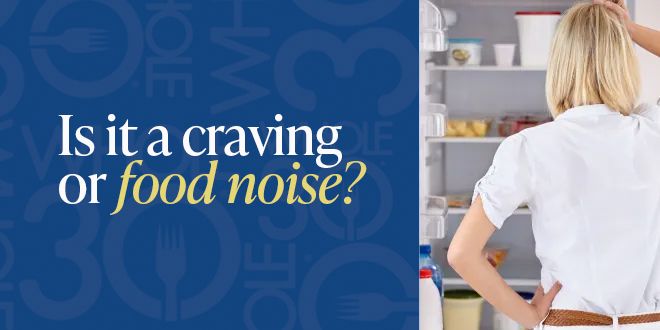By Melissa Urban, Whole30 co-founder and CEO. Reviewed by Summer Kessel, RD
Every few months, I buy a bag of mini-peanut butter cups. They are one of my favorite treats, but I don’t need a full-sized version to feel satisfied. When I get a hankering, I’ll eat one, savor it, and go about my business. I like keeping a bag in my office, because when I want one, I want one. More times than not, I forget I even have the bag, and delightedly discover it a few weeks later.
My husband, on the other hand, is an eat-the-whole-thing guy. Whether it’s a pint of ice cream, a bag of chips, a bag of mini-peanut butter cups… he eats until it’s gone. Also, nothing stays in the house. If he buys it, he’s eating it right away. There is no “I bought this in case I want some later.”
It took me years to understand why my husband and I behave so differently around food. It’s not about willpower, discipline, or even hunger.
My husband has food noise. I do not.
Food noise, defined
Biologically, we are primed to respond to a variety of food cues. Seeing or smelling food, walking by your favorite bakery, watching others eat, feeling your stomach growl naturally lead to thoughts and desires of food.
From an evolutionary perspective, this was a survival advantage, helping us act quickly whenever food was available.
Food cue: External and internal triggers that can elicit thoughts and desires of food.
However, there is a wide variance in how people respond to food cues. For some, smelling freshly baked bread may spark a fleeting response (“that bread smells good”), which quickly passes. For others, this same cue can snowball into constant rumination—a series of continuous, looping thoughts about food and eating. These thoughts can feel intrusive and all-consuming, and lead to increased food-seeking, overeating, and impulsive eating.
There is no universal definition of food noise, as it is not yet a clinical term. Conceptually, it refers to a persistent and intrusive preoccupation with food that goes beyond a normal response to food cues or hunger.
Food noise: A persistent and intrusive preoccupation with food that goes beyond normal food and hunger cues.
Food noise can manifest in a number of different ways, such as:
- Constantly anticipating or planning your next meal
- Centering your life around food
- Feeling unsatisfied no matter how much you eat
- Obsessing about eating, even when you’re not hungry.
Registered dietitian Summer Kessel says, “Patients describe food noise as constant, repetitive, unwanted, and distressing. It can reach a point where it interferes with their focus, daily functioning, physical and mental health, and social relationships.”
Food noise can also occur in contexts unrelated to the physical presence of food, mealtimes, food cues, or hunger. It can be triggered or exacerbated by factors like stress, boredom, restrictive dieting, hormonal imbalances, lack of sleep, or genetic predispositions.
For my husband, lack of sleep is a huge factor in his food noise. When he’s working on a big project with a tight deadline, he’ll often wake up at 3 or 4 a.m. with his mind racing. “This kicks my food noise into high gear from the moment I wake up,” he says. “I’ll come upstairs to the fridge or pantry far more often on these days, and feel constantly distracted by food. My cravings are also more persistent.”
Food noise vs. cravings
Food noise is different from a craving.
Craving: A specific and short-term desire to eat a rewarding food, brought on by external or internal food cues, which dissipates once satisfied or over time.
Understanding this distinction is important. Cravings are a near-universal experience, and simpler than food noise. They are typically noticed or recognized, then successfully satisfied with an appropriate response (such as eating that food, satisfying general hunger, drinking water, or employing a distraction technique).
Food noise, by comparison, is not common to all, and far more complex. It extends beyond internal and external cues, showing up as persistent “mental chatter.” There isn’t a single technique or behavior that reliably reduces food noise to a comfortable level.
Finally, though food cravings do play a role in food noise, they are certainly not the only component. This food-related mental chatter can also include:
- Whether you are eating the “right” way
- Whether you’re gaining weight
- How your meals are sized or proportioned
- Whether these foods are available
- When you’ll be able to eat next
- Anxiety around your food choices
- Experiencing negative emotions like shame, guilt, or judgment around eating
| Craving | Food Noise |
|---|---|
| A short-term desire for a specific rewarding food | Non-specific and broad thoughts, plans, and urges related to food and eating |
| Brought on by external food cues | May be exacerbated by cues, but can exist independently |
| Can feel urgent, but not distressing | Feels intrusive, distracting, and exhausting |
| Dissipates once satisfied or over time | Persistent; does not dissipate or result in satisfaction upon eating |
To understand the impact of food noise, it helps to hear what it actually feels like.
What does food noise feel like?
“I am always thinking about food,” my husband says. “When I’m making lunch, I’m thinking about what I’m going to eat for dinner. When I’m working, I’m constantly tempted to check the fridge or pantry. When I’m done eating, even if I feel stuffed, my brain is still telling me to eat. I can willpower my way through it, sometimes. But no matter what I do, it never stops.”
Thinking about food isn’t inherently problematic. Looking forward to a treat or enjoying the sensory experience of food is normal, and even pleasurable. Taking inventory of your pantry and planning meals can feel practical and rewarding. Label reading and learning more about nutrition can improve your quality of life.
Food noise can be affected by the same external and internal factors. However, food noise is not a pleasurable, rewarding, or life-improving experience. The thoughts and feelings brought on by food noise are intrusive, repetitive, distressing, and disruptive.
Though there are commonalities in how people describe food noise, no two experiences are the same. From the Whole30 community:
- “Food noise shows up as a preoccupation with the food I am consuming, am about to consume, or will consume in the future. It’s a mental obsession.” —Jennifer
- “Food noise has always felt like this imaginary person telling me when, what, and how much I should eat at all times, hungry or not hungry. It honestly feels like a mental eating disorder.” —Allison
- “Food noise means when I get it, I don’t stop until it’s all gone. An entire bag of chips, an entire pint of ice cream, a bag of cookies, cake. The noise doesn’t stop until I fulfill it. Then, the noise will change to something else. It’s all consuming.” —Anonymous
- “Food noise would drive me to tears—it would turn into headaches, constant anticipatory salivation, and stomach aches. Every now and then I could get reprieve through distractions or a salty/sugary treat, but it made it really hard to work my full-time job.” —Bree
- “Food noise is a constant loop of ‘I want to eat this, I shouldn’t eat this, can I eat this, why did I eat this’… there is a lot of shame and guilt underscoring eating and food.” —Anonymous
Food noise exists on a spectrum. For some, it’s not constant, and can be at least partially quelled by distraction, mindfulness, and diet and lifestyle practices. For others, it progresses to rumination, looping thoughts, and distraction, which may vary in intensity from moment to moment or day to day. On the far end, food noise can become an obsessive and constant preoccupation, disrupting everyday life and leading to negative health outcomes.
The impact of food noise can be seen in a number of areas. Physically, food noise can promote overeating, unwanted weight gain, disordered eating habits, and lifestyle-related diseases and conditions. Psychologically, it can manifest as guilt, shame, mental anguish, and self-recrimination. Collectively, these feelings can present a significant mental and emotional burden. Socially, food noise can interfere with relationships, leading to tension with family and friends, social withdrawal, and arguments over food.
How to quiet food noise
Being able to differentiate between food noise and typical cravings or thoughts around food is the first step to addressing it. There are a variety of factors and behaviors that might, to some degree and for some people, manage or relieve food noise. There are also some behaviors that turn up the volume, near-universally.
The restriction of calories, meals, or macronutrients (like dietary fat) often exacerbates food noise. This is especially true if calories are restricted below what your body needs for energy balance. This triggers hormonal changes that make you hungrier, and less satisfied when you do eat. Restriction of this nature also makes your brain fixate on food, increasing food noise and often leading to overeating. If this cycle repeats (“yo-yo dieting”), it can worsen food noise even outside of the restriction phase. Breaking the cycle of restriction and overeating can reduce the frequency or severity of food noise. (An experienced therapist can offer targeted guidance and support.)
Weight loss diet culture messaging also plays a role in intensifying food noise. This system labels foods as “bad,” “toxic,” “junk,” and “unhealthy,” and by extension, makes you “bad” or “guilty” when you eat them. This moral framing creates a cycle of judgment, shame, and self-monitoring. The constant evaluation of what you should or shouldn’t eat keeps the brain locked in a state of vigilance. Here, the noise doesn’t just stem from hunger—it also comes from the endless mental negotiations and negative self-talk. Rejecting weight loss diet culture and embracing food neutrality, weight neutrality, and other alternative constructs may help soften the tone and aggressiveness of food noise.
As mentioned, food noise can also be exacerbated by dietary and lifestyle factors. In theory, improving blood sugar regulation, digestion, sleep quality, stress, and emotional regulation could reduce the physiological triggers of food noise. However, the very presence of food noise likely presents a significant barrier to implementing those lifestyle changes. Imagine trying to change your diet while someone is constantly whispering in your ear, “Just have one. Pizza would taste so good right now. Just go look in the fridge? Should you be eating that? Why did you eat that much? You know there’s some ice cream left…”
It’s easy to see how sustaining change would be so much harder given the “voice” of food noise. In addition, many who have been able to initiate those changes report that dietary and lifestyle interventions alone have not led to much, if any, improvement in food noise.
The presence of food noise likely presents a significant barrier to implementing lifestyle changes that could help keep the noise at bay.
The only intervention that has reliably and consistently reduced or eliminated food noise is glucagon-like peptide-1 receptor agonists. Commonly known as GLP-1s, these medications (like Ozempic/Wegovy/semaglutide, and Mounjaro/Zepbound/tirzepitide) act in the gut and the brain, calming the neural pathways that drive appetite and reward. When combined with a balanced and nourishing diet, they have been shown to reduce appetite and cravings, and significantly improve fullness and satiety. To varying degrees, people also report these medications dramatically reduce or eliminate food noise.
Researchers are only beginning to understand how GLP-1s act in the digestive system and the brain. Studies are focused on the brain and body processes that control hunger, satiety, pleasure, and reward. Another goal is to better understand why and how these sensations become dysregulated, causing compulsive behaviors and addictive patterns.
Food noise is not about willpower
My husband has been able to implement sustainable dietary changes, dramatically reducing sugar and ultra-processed foods. He’s improved his sleep by turning off screens and going to bed earlier. He exercises six days a week, and is incredibly active in his job as a videographer and photographer. He underwent comprehensive lab testing to rule out hidden health issues. He also regularly practices stress management techniques like journaling, spending time outside, and creative work.
Still, his food noise persists. “Some days are worse than others,” he says. “But even when the volume is low, that voice is always there, demanding I pay attention.”
Food noise is not the result of weakness, or a lack of willpower. In fact, researchers believe the concept of food noise could be profoundly clinically relevant. People struggling to make sustainable dietary changes are often told their willpower simply isn’t strong enough. The concept of food noise could provide a biological and psychological explanation for emotional eating, overeating, and impulsive eating.
Recognizing food noise for what it is—an interplay of biology, psychology, and lived experience—helps lift the shame so many people carry about their eating habits. Continuing research of food noise opens the door to more effective, compassionate interventions—and perhaps, for the first time, quiet.
Resources
Hayashi D, Edwards C, Emond JA, Gilbert-Diamond D, Butt M, Rigby A, Masterson TD. What Is Food Noise? A Conceptual Model of Food Cue Reactivity. Nutrients. 2023 Nov 17;15(22):4809. doi: 10.3390/nu15224809. PMID: 38004203; PMCID: PMC10674813.
Dhurandhar EJ, Maki KC, Dhurandhar NV, Kyle TK, Yurkow S, Hawkins MAW, Agley J, Ho EH, Cheskin LJ, Sørensen TIA, Wang XR, Allison DB. Food noise: definition, measurement, and future research directions. Nutr Diabetes. 2025 Jul 8;15(1):30.
Young, Lauren J. “Ozempic Quiets Food Noise in the Brain — But How?” Scientific American, 25 June 2024, scientificamerican.com/article/ozempic-quiets-food-noise-in-the-brain-but-how/
.Kessel, Summer. July 15, 2025. Living Your Healthiest Semaglutide Life: A Complete Guide to Nutrition and Mindset While on GLP-1 Medications. Fair Winds Press.
















